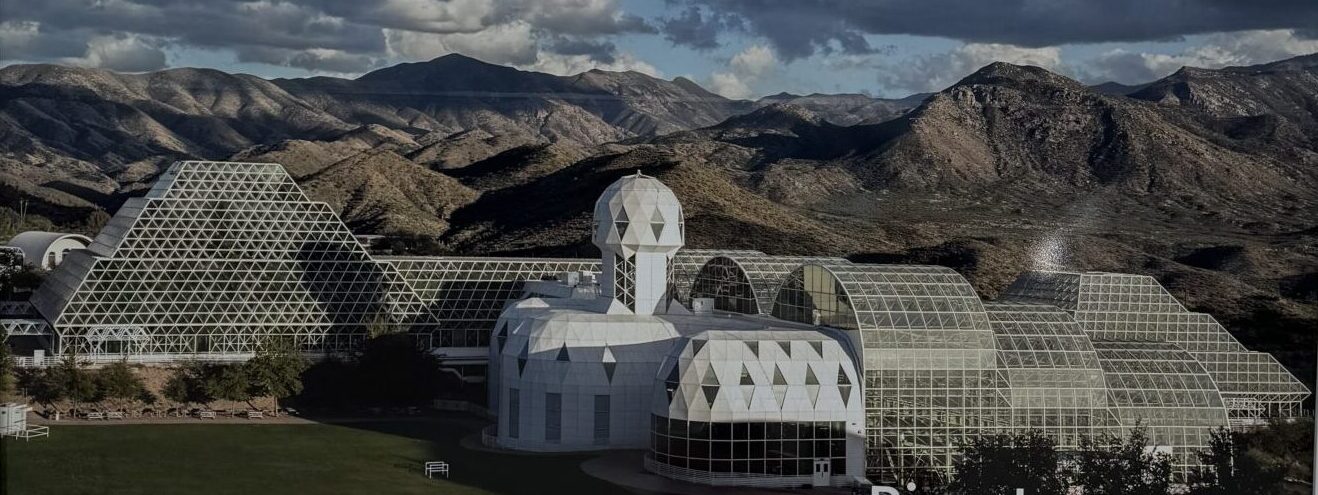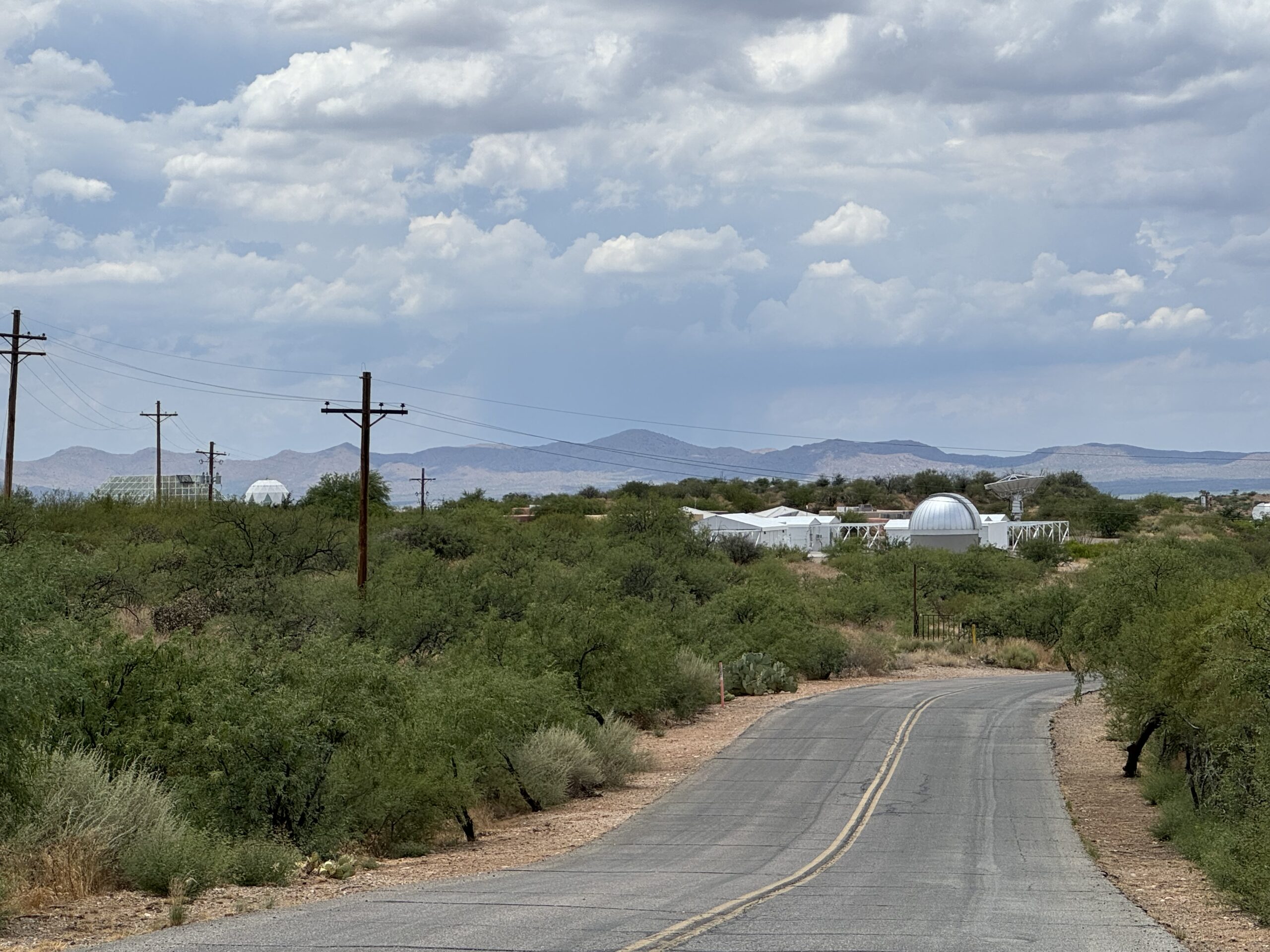Originally conceived as a way to study and develop self-sustaining space colonization technology, Biosphere 2 has evolved into a center for research, education, and public outreach focused on understanding Earth’s complex ecosystems.
The Vision and History of Biosphere 2
Biosphere 2 was constructed between 1987 and 1991, backed by an ambitious vision to create a closed ecological system that could support human life. This $150 million project aimed to study how humans could potentially live in self-sustaining environments on other planets. The structure spans 3.14 acres and houses multiple biomes, including rainforest, ocean, desert, and savanna, all under one roof.
In 1991, the first group of eight “Biospherians” was sealed inside Biosphere 2 for a two-year mission to live and work within the closed system. However, the mission faced significant challenges, such as a drastic decline in oxygen levels, unexpected die-offs of plant and animal species, and difficulties in maintaining balanced ecosystems. Food production was insufficient, leading to caloric deficits and weight loss among the crew.
Despite these issues, the Biospherians managed to stay inside for the entire two-year duration. The oxygen levels dropped from 21% to 14.2%, causing hypoxia symptoms. To address this, additional oxygen was pumped into the facility in January 1993, adding about 79,000 cubic feet of liquid oxygen to stabilize the levels. This intervention, while necessary for the health of the crew, compromised the original goal of complete self-sufficiency. The mission highlighted the complexities of maintaining a closed ecological system and the technical challenges involved.
The second mission began in 1994 but faced similar problems, including ecological imbalances and technical failures, and was further disrupted by management disputes and financial difficulties. It ended prematurely after six months.
After the second mission of Biosphere 2 ended in 1994, the facility underwent several changes in ownership and purpose. Columbia University assumed management in 1996 and used the facility for research, education, and public outreach. Columbia conducted studies on biogeochemical cycles, ecological dynamics, and the impacts of climate change.
In 2005, management was transferred to a private company, and in 2007, Biosphere 2 was sold to CDO Ranching & Development. The new owners initially considered redeveloping the property for residential use. However, recognizing its scientific and educational value, the University of Arizona stepped in that same year to continue its operation as a research and education facility. The university revitalized the facility, transforming it into a hub for scientific research and education.
Today, Biosphere 2 is used for large-scale experiments that are not possible in traditional laboratories. Research focuses on Earth systems science, including studies on water cycles, climate change, and the interactions between ecosystems and the atmosphere.

The Architecture and Biomes
One of the most fascinating aspects of Biosphere 2 is its architecture. The glass and steel structure is a marvel of engineering, designed to create distinct ecological zones known as biomes; they include:
Tropical Rainforest: The rainforest biome replicates a tropical rainforest environment, with a diverse array of plant species, high humidity, and controlled precipitation. It is used to study rainforest ecology, plant physiology, and the impacts of climate change on tropical ecosystems.
Ocean: This biome includes a 700,000-gallon ocean Complete with a coral reef and a wave machine, designed to mimic marine environments. It provides a controlled setting for research on oceanography, marine biology, and the effects of ocean acidification and climate change on coral reefs and marine life.
Mangrove Wetlands: The mangrove wetlands biome simulates the unique ecosystem of coastal mangrove forests. Research in this biome focuses on the role of mangroves in coastal protection, carbon sequestration, and their response to environmental stressors such as rising sea levels.
Savannah Grassland: This biome replicates a savannah grassland environment, with grassy plains and scattered trees. Studies here examine grassland ecology, plant-animal interactions, and the effects of changes in precipitation and temperature on grassland ecosystems.
Fog Desert: The fog desert biome mimics arid desert environments that rely on fog for moisture. It provides insights into desert plant adaptations, water use efficiency, and the impact of climate change on desertification processes.
Agricultural System: The agricultural biome is designed to support crop growth and study sustainable agricultural practices. It includes various crops and allows researchers to explore topics such as soil health, crop productivity, and the effects of different farming techniques on food production and ecosystem health.

Hours, Admission, and Tours
Biosphere 2 is open daily from 9 AM to 4 PM, with steep entrance prices including $27 for adults and $15 for kids 5-17 (children under 5 are free).
Tours
Tours through Biosphere 2 are self-guided and can be accompanied by an audio explanation of the tour stops through an app downloaded to your phone. The tour takes approximately an hour and 15 minutes.
For an additional $12 you can get a behind-the-scenes tour of the technology that runs the facility. The guided tour is a 30-minute tour where you can see one of the “lungs” that regulates the air pressure inside the main glass enclosure.

Final Note:
After sharing all of this with you, the truth is we only looked from the outside and the visitor center and didn’t do the tour. Our kids were quite tired and we were there in the middle of the summer in the Arizona heat. The price also seemed quite high for what they were offering. They weren’t up for a mile walk with half of it in the outside heat and the other half in and out through arid desert and humid rainforest. But this is on our list of items still to visit! If you visit, let us know how it is!


